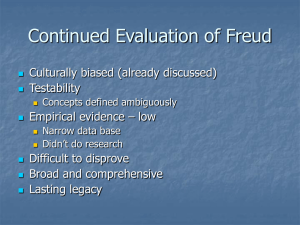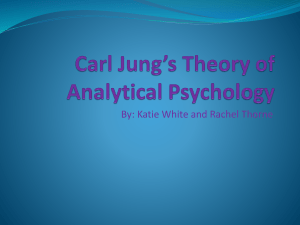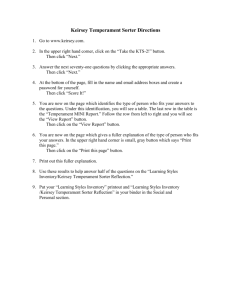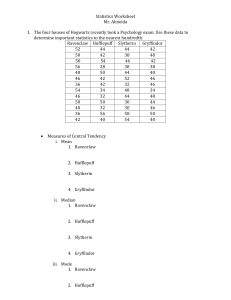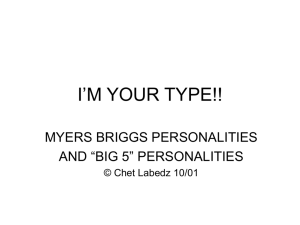Learning Styles
advertisement
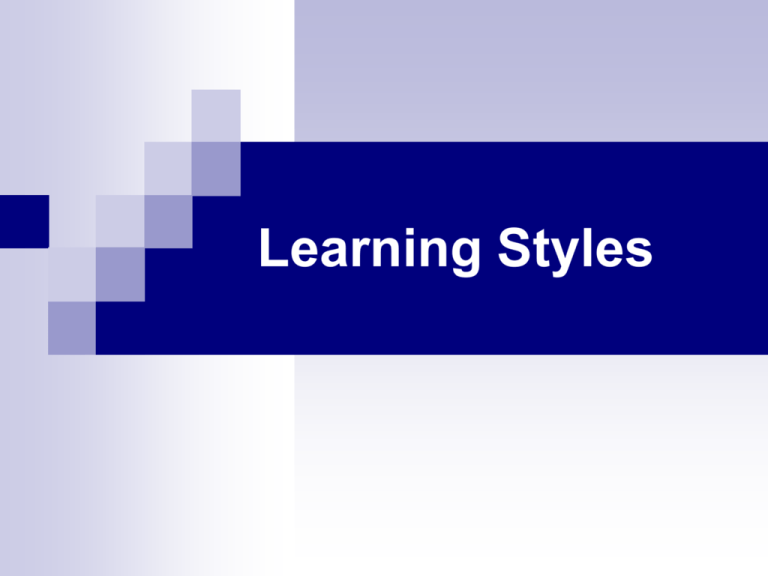
Learning Styles Learning style a consistent pattern of behaviour within a range of individual variability (Cornet, 1983); a student's consistent way of responding to and using stimuli in a learning environment (Claxton & Ralston, 1978); how individuals process information and prefer to learn (Garity, 1985); the way individuals organise information and experiences (Laschinger & Boss, 1984); a person's characteristic style of acquiring and using information (Haynsake, 1981) and; an expression of psychological differentiation within characteristic modes of information processing (Witkin & Goodenough, 1971, 1981). 2 A bit like Harry Potter’s Sorting Hat... 4 "You might belong in Gryffindor, Where dwell the brave at heart, Their daring, nerve, and chivalry Set Gryffindors apart” 5 "Here in wise old Ravenclaw, If you've a ready mind, Those of wit and learning, Will always find their kind." 6 "Here you are in Slytherin, Where you'll make your real friends, Those cunning folk use any means To achieve their ends." 7 "You belong in Hufflepuff, Where they are just and loyal, Those patient Hufflepuffs are true And unafraid to toil" 8 "You might belong in Gryffindor, Where dwell the brave at heart, There daring, nerve, and chivalry Set Gryffindors apart” "You belong in Hufflepuff, Where they are just and loyal, Those patient Hufflepuffs are true And unafraid to toil" "Here in wise old Ravenclaw, If you've a ready mind, Those of wit and learning, Will always find their kind." "Here you are in Slytherin, Where you'll make your real friends, Those cunning folk use any means To achieve their ends." 9 Learning Styles Models Meyers-Briggs Type Indicator 10 History of Learning Styles Carl Jung Carl Gustav Jung (1875 – 1961) was a Swiss psychiatrist, an influential thinker and the founder of analytical psychology (also known as Jungian psychology). Two processes that are important in learning how we take in information what we do with the information once it is in our brains He called the first PERCEPTION and the second JUDGEMENT 12 Carl Jung: Perception Two types of perceivers those who can only process on sense at a time, i.e. they can look but can’t listen And those can taken in all senses simultaneously and bring all the sense data together to make a holistic overview He called the first type of person a SENSOR and the second an INTUITOR 13 Carl Jung: Judgment Two types of judgers those who can make decisions based on their heart And those make decisions based on their head He called the first type of person a FEELER and the second an THINKER 14 Carl Jung’s Model of Learning Styles Sensing Perception Thinking Feeling Judgement Intuiting 15 Myers-Briggs Type Indicator (MBTI) Designed to measure psychological preferences in how people perceive the world and make decisions. These preferences were based on Carl Jung’s ideas The original developers of the personality inventory were Katharine Cook Briggs and her daughter, Isabel Briggs Myers. Began creating the indicator during World War II, believing that a knowledge of personality preferences would help women who were entering the industrial workforce for the first time identify the sort of war-time jobs where they would be "most comfortable and effective. 16 Myers-Briggs Type Indicator 17 18 Wants to talk through their ideas in order to clarify them. LEARNS BY TEACHING OTHERS Gathers information from numerous sources. Likes to reflect and clarify before speaking CONCERNED WITH THEIR OWN UNDERSTANDING 19 Interested in the patterns and relationships between the facts, discovery learning, they try to develop new original solutions LIKE SIMULATIONS OR EXPERIMENTS Focus on facts and details. Like structured lectures, guidelines and objectives. Tend to apply standard solutions CONCERNED WITH WHAT MUST BE KNOWN 20 Subjective in their decision making and consider how their decisions affect others, like small group exercises OPEN-ENDED CONSTRUCTIVISTIC FORMATS Reply on analysis, logic and existing principles. Like tests to measure progress. ANALYSE CASE STUDIES 21 Prefer flexibility and adaptability, often postpone doing work until the very last minute SEEK INFORMATION UNTIL THE DEADLINE (AND OFTEN BEYOND) Prefer structure and organisation, appreciate any resources that can help them plan their work DEADLINES ARE SACRED 22 23 Other Learning Styles Models 24 Keirsey Temperament Sorter Guardians Idealists Artisans Rationals 25 Keirsey Temperament Sorter Guardians are sensible, down-to-earth people who are the backbone of institutions and the true stabilisers of society. Idealists believe that friendly co-operation is the best way for people to achieve their goals. They dream of removing the walls of conflict and selfishness that divide people Whatever their field, Rationals set out to comprehend the natural world in all its complexity. Artisans are most at home in the external world of solid objects that can be made and manipulated, and of real-life events that can be experienced in the here and now. 26 Relationship between Keirsey Temperament Sorter and MBTI 27 Kolb’s Learning Style Inventory 28 Kolb’s Learning Style Inventory Theorists: Like case studies, theory readings, and thinking alone. Their strengths lie in their ability to create theoretical models. Pragmatists: peer feedback; activities that apply skills; self-directed autonomous learner. The pragmatist's greatest strength is in the practical application of idea. Activists: like practising the skill, problem solving, small group discussions, peer feedback; trainer should be a model of a professional, leaving the learner to determine her own criteria for relevance of materials. Reflectors: like lectures with plenty of reflection time; trainer should provide expert interpretation - taskmaster/guide; judge performance by external criteria. Their strengths lie in an imaginative ability. 29 Hermann Brain Dominance 30 Lewin’s Learning Cycle 31 Honey-Mumford Model 32 Gregorc Learning Style Abstract Sequential Abstract Concrete Random Random Concrete Sequential 33 Try out the Gregorc Inventory...
